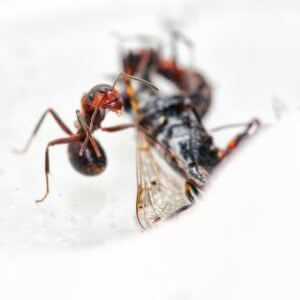Harvester Ants
Quick Stats
- Latin Name: Pogonomyrmex spp.
- Size: Extremely large, measuring anywhere from 5mm to 10mm in length
- Color: Various colors including red, black, and brown or some combination thereof
- Shape: Harvester ants have very thin thoraxes and long feeler antennae. Most also have large mandibles with which to cut and move food
- Found in: Most commonly found in the Western United States. Texas has a large population and the California harvester ant is a species native to the Golden State.
- Overview: The term Harvester ant is used to describe any ant species that harvests food for storage and to feed later. Common food sources include grains, leaves, and other organic matter which is stored within granaries in the nest.
About Harvester Ants
 There are dozens of species of Harvester ants in the United States, all with their own unique organization, breeding patterns, and feeding requirements. The three most common species include the red harvester, the western harvester, and the California harvester. Of these, the red harvester is the most dangerous and aggressive; its sting is very painful and may actually cause an allergic reaction in some people.
There are dozens of species of Harvester ants in the United States, all with their own unique organization, breeding patterns, and feeding requirements. The three most common species include the red harvester, the western harvester, and the California harvester. Of these, the red harvester is the most dangerous and aggressive; its sting is very painful and may actually cause an allergic reaction in some people.
Because they survive by feeding on plant sources in their local area, harvester ants are actually a very important part of the ecosphere. They both disperse plant seeds which leads to new growth or become plant predators in a particular vicinity. Because their nests need so much room for “granaries” that are used to store the harvested food they can measure feet below the earth’s surface. Due to their habitat – often hot, arid locations – harvester ants wait until after rainfall to gather uncovered seed and soak up residual moisture.
Signs of Harvester Ants
Harvester ants really don’t like to nest indoors. They need malleable soil to dig deep, heavily-secured permanent nests and few indoor locations provide such surfaces. In some cases, harvester ants have been known to dig out nests in the dirt crawlspace or basement of a home. The most noticeable sign of a harvester ant infestation is an above-ground mound which can measure whole feet across.
Most species only eat one thing at a time – a particular insect or grain – and can travel long distances in search of the food. If caught on their way back to the nest it’s possible to actually see the grain or seed a harvester ant is carrying in its jaws. Because most are poisonous, it’s never advisable to attempt to eradicate harvesters yourself. If you’ve noticed signs of harvester ant mounds or even individual harvester ants around your home or property, call in a professional immediately.

